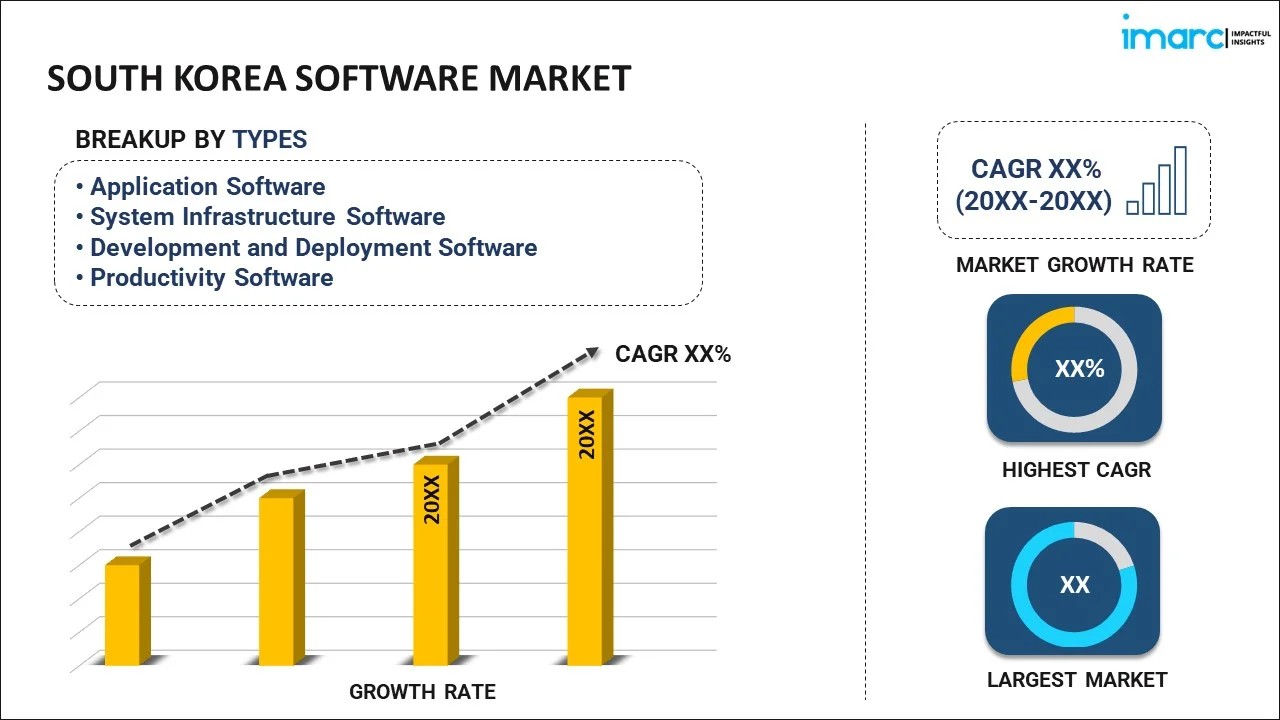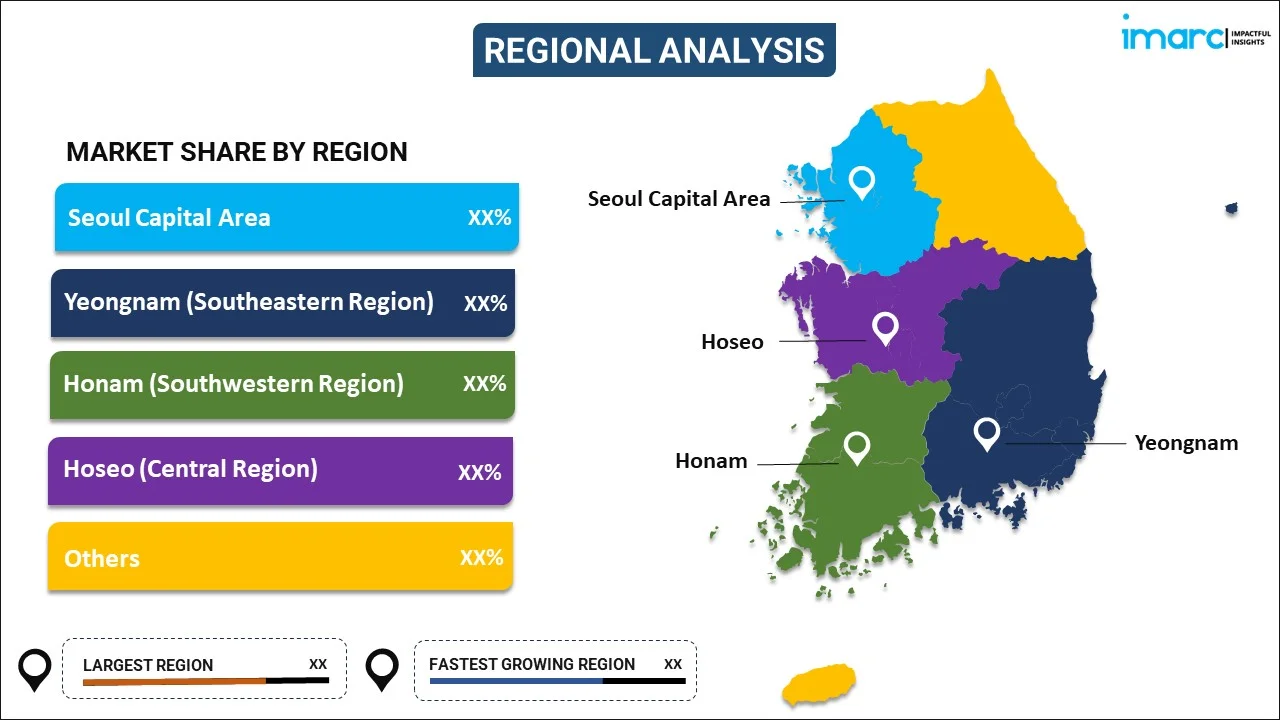
South Korea Software Market Report by Type (Application Software, System Infrastructure Software, Development and Deployment Software, Productivity Software), Deployment Mode (On-premises, Cloud-based), Enterprise Size (Small and Medium-sized Enterprises, Large Enterprises), Industry Vertical (IT and Telecom, BFSI, Retail, Government/Public Sector, Energy and Utilities, Healthcare, and Others), and Region 2025-2033
Market Overview:
The South Korea software market size is projected to exhibit a growth rate (CAGR) of 4.92% during 2025-2033. The emerging technological advancements, growing number of highly educated and skilled workforce particularly in STEM fields, and the implementation of several initiatives and policies encouraging research and development (R&D), startup growth, and digital transformation represent some of the key factors driving the market.
|
Report Attribute
|
Key Statistics
|
|---|---|
|
Base Year
|
2024 |
|
Forecast Years
|
2025-2033 |
|
Historical Years
|
2019-2024
|
| Market Growth Rate (2025-2033) | 4.92% |
Software is a collection of change instructions or programs employed to operate computers and execute specific tasks. It is the non-tangible component of computers, which is contrasted with hardware. It allows users to perform several tasks ranging from simple calculations to complex programming. There are two primary types of software, including system software and application software. System software includes the operating system and all the utilities that allow the computer to function. Operating systems such as Windows, macOS, and Linux manage the hardware resources of the computer and provide the platform upon which application software runs. Utilities are system software components that perform specific, limited functions, usually related to managing system resources. Additionally, application software is designed to help users perform specific tasks, which include software such as word processors, spreadsheets, media players, and database applications. These programs are often designed with user-friendliness in mind, allowing individuals to complete various tasks efficiently. Software development involves programming, testing, and bug fixing, which is essential for creating, maintaining, and supporting software.
South Korea Software Market Trends:
The market is primarily driven by the emerging technological advancements. In addition, South Korea is home to some of the leading technology companies, such as Samsung and LG. These corporations are major players in hardware and also invest heavily in software development which is contributing to the market growth. South Korea's advancements in areas such as fifth-generation (5G) technology are further propelling the software industry, allowing more sophisticated and high-speed services. Moreover, the implementation of several initiatives and policies encourages research and development (R&D), startup growth, and digital transformation. For instance, the government's focus on the Digital New Deal aims to accelerate the digitalization of the economy and improve the software sector, representing another major growth-inducing factor. Besides this, the rapid adoption of new technologies and the growing tech-savvy populations are open to embracing new digital solutions, which creates a large, receptive market for software products, encouraging domestic and international companies to invest in the South Korean software market. Along with this, the rising number of highly educated and skilled workforce, particularly in Science, Technology, Engineering, and Mathematics (STEM) fields, are propelling the market growth. Also, the country's emphasis on education and training in technology-related areas is creating a talent pool well-equipped to meet the rising demands of the growing software industry. Furthermore, the growing focus on future-oriented technologies, including artificial intelligence (AI) and big data integrated into various software applications, is enhancing their capabilities and creating new market opportunities across the region.
South Korea Software Market Segmentation:
IMARC Group provides an analysis of the key trends in each segment of the market, along with forecasts at the country level for 2025-2033. Our report has categorized the market based on type, deployment mode, enterprise size, and industry vertical.
Type Insights:

- Application Software
- Enterprise Resource Planning (ERP)
- Customer Relationship Management (CRM)
- Supply Chain Management (SCM)
- Enterprise Collaboration Software
- Enterprise Content Management (ECM) Software
- Education Software
- Others
- System Infrastructure Software
- Network Management Systems (NMS)
- Storage Software
- Security Software
- Development and Deployment Software
- Enterprise Data Management (EDM)
- Business Analytics and Reporting Tools
- Application Servers
- Integration and Orchestration Middleware
- Data Quality Tools
- Productivity Software
- Office Software
- Creative Software
- Others
The report has provided a detailed breakup and analysis of the market based on the type. This includes application software (enterprise resource planning (ERP), customer relationship management (CRM), supply chain management (SCM), enterprise collaboration software, enterprise content management (ECM) software, education software, and others), system infrastructure software (network management systems (NMS), storage software, and security software), development and deployment software (enterprise data management (EDM), business analytics and reporting tools, application servers, integration and orchestration middleware, and data quality tools), and productivity software (office software, creative software, and others).
Deployment Mode Insights:
- On-premises
- Cloud-based
A detailed breakup and analysis of the market based on the deployment mode have also been provided in the report. This includes on-premises and cloud-based.
Enterprise Size Insights:
- Small and Medium-sized Enterprises
- Large Enterprises
The report has provided a detailed breakup and analysis of the market based on the enterprise size. This includes small and medium-sized enterprises and large enterprises.
Industry Vertical Insights:
- IT and Telecom
- BFSI
- Retail
- Government/Public Sector
- Energy and Utilities
- Healthcare
- Others
A detailed breakup and analysis of the market based on the industry vertical have also been provided in the report. This includes IT and telecom, BFSI, retail, government/public sector, energy and utilities, healthcare, and others.
Regional Insights:

- Seoul Capital Area
- Yeongam (Southeastern Region)
- Honam (Southwestern Region)
- Hoseo (Central Region)
- Others
The report has also provided a comprehensive analysis of all the major regional markets, which include Seoul Capital Area, Yeongam (Southeastern Region), Honam (Southwestern Region), Hoseo (Central Region), and Others.
Competitive Landscape:
The market research report has also provided a comprehensive analysis of the competitive landscape in the market. Competitive analysis such as market structure, key player positioning, top winning strategies, competitive dashboard, and company evaluation quadrant has been covered in the report. Also, detailed profiles of all major companies have been provided.
South Korea Software Market Report Coverage:
| Report Features | Details |
|---|---|
| Base Year of the Analysis | 2024 |
| Historical Period | 2019-2024 |
| Forecast Period | 2025-2033 |
| Units | Million USD |
| Scope of the Report | Exploration of Historical Trends and Market Outlook, Industry Catalysts and Challenges, Segment-Wise Historical and Future Market Assessment:
|
| Types Covered |
|
| Deployment Modes Covered | On-premises, Cloud-based |
| Enterprise Sizes Covered | Small and Medium-sized Enterprises, Large Enterprises |
| Industry Verticals Covered | IT and Telecom, BFSI, Retail, Government/Public Sector, Energy and Utilities, Healthcare, Others |
| Regions Covered | Seoul Capital Area, Yeongam (Southeastern Region), Honam (Southwestern Region), Hoseo (Central Region), Others |
| Customization Scope | 10% Free Customization |
| Post-Sale Analyst Support | 10-12 Weeks |
| Delivery Format | PDF and Excel through Email (We can also provide the editable version of the report in PPT/Word format on special request) |
Key Questions Answered in This Report:
- How has the South Korea software market performed so far and how will it perform in the coming years?
- What has been the impact of COVID-19 on the South Korea software market?
- What is the breakup of the South Korea software market on the basis of type?
- What is the breakup of the South Korea software market on the basis of deployment mode?
- What is the breakup of the South Korea software market on the basis of enterprise size?
- What is the breakup of the South Korea software market on the basis of industry vertical?
- What are the various stages in the value chain of the South Korea software market?
- What are the key driving factors and challenges in the South Korea software?
- What is the structure of the South Korea software market and who are the key players?
- What is the degree of competition in the South Korea software market?
Key Benefits for Stakeholders:
- IMARC’s industry report offers a comprehensive quantitative analysis of various market segments, historical and current market trends, market forecasts, and dynamics of the South Korea software market from 2019-2033.
- The research report provides the latest information on the market drivers, challenges, and opportunities in the South Korea software market.
- Porter's five forces analysis assist stakeholders in assessing the impact of new entrants, competitive rivalry, supplier power, buyer power, and the threat of substitution. It helps stakeholders to analyze the level of competition within the South Korea software industry and its attractiveness.
- A competitive landscape allows stakeholders to understand their competitive environment and provides an insight into the current positions of key players in the market.
Need more help?
- Speak to our experienced analysts for insights on the current market scenarios.
- Include additional segments and countries to customize the report as per your requirement.
- Gain an unparalleled competitive advantage in your domain by understanding how to utilize the report and positively impacting your operations and revenue.
- For further assistance, please connect with our analysts.
 Inquire Before Buying
Inquire Before Buying
 Speak to an Analyst
Speak to an Analyst
 Request Brochure
Request Brochure
 Request Customization
Request Customization




.webp)




.webp)












